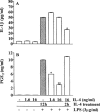Cytokine-mediated inflammatory hyperalgesia limited by interleukin-4
- PMID: 10051119
- PMCID: PMC1565777
- DOI: 10.1038/sj.bjp.0702266
Cytokine-mediated inflammatory hyperalgesia limited by interleukin-4
Abstract
1. The effect of IL-4 on responses to intraplantar (i.pl.) carrageenin, bradykinin, TNFalpha, IL-1beta, IL-8 and PGE2 was investigated in a model of mechanical hyperalgesia in rats. Also, the cellular source of the IL-4 was investigated. 2. IL-4, 30 min before the stimulus, inhibited responses to carrageenin, bradykinin, and TNFalpha, but not responses to IL-1beta, IL-8 and PGE2. 3. IL-4, 2 h before the injection of IL-1beta, did not affect the response to IL-1beta, whereas IL-4, 12 or 12+2 h before the IL-1beta, inhibited the hyperalgesia (-30%, -74%, respectively). 4. In murine peritoneal macrophages, murine IL-4 for 2 h before stimulation with LPS, inhibited (-40%) the production of IL-1beta but not PGE2. Murine IL-4 (for 16 h before stimulation with LPS) inhibited LPS-stimulated PGE2 but not IL-1beta. 5. Anti-murine IL-4 antibodies potentiated responses to carrageenin, bradykinin and TNFalpha, but not IL-1beta and IL-8, as well as responses to bradykinin in athymic rats but not in rats depleted of mast cells with compound 40/80. 6. These data suggest that IL-4 released by mast cells limits inflammatory hyperalgesia. During the early phase of the inflammatory response the mode of action of the IL-4 appears to be inhibition of the production TNFalpha, IL-1beta and IL-8. In the later phase of the response, in addition to inhibiting the production of pro-inflammatory cytokines, IL-4 also may inhibit the release of PGs.
Figures





Similar articles
-
Cytokine-mediated inflammatory hyperalgesia limited by interleukin-1 receptor antagonist.Br J Pharmacol. 2000 Jul;130(6):1418-24. doi: 10.1038/sj.bjp.0703434. Br J Pharmacol. 2000. PMID: 10903985 Free PMC article.
-
Cytokine-mediated inflammatory hyperalgesia limited by interleukin-13.Eur Cytokine Netw. 2001 Apr-Jun;12(2):260-7. Eur Cytokine Netw. 2001. PMID: 11399514
-
Role of lipocortin-1 in the anti-hyperalgesic actions of dexamethasone.Br J Pharmacol. 1997 Jul;121(5):883-8. doi: 10.1038/sj.bjp.0701211. Br J Pharmacol. 1997. PMID: 9222544 Free PMC article.
-
Cytokine-mediated inflammatory hyperalgesia limited by interleukin-10.Br J Pharmacol. 1995 Jun;115(4):684-8. doi: 10.1111/j.1476-5381.1995.tb14987.x. Br J Pharmacol. 1995. PMID: 7582491 Free PMC article.
-
Interleukin-1 as a mediator of fatigue in disease: a narrative review.J Neuroinflammation. 2017 Jan 21;14(1):16. doi: 10.1186/s12974-017-0796-7. J Neuroinflammation. 2017. PMID: 28109186 Free PMC article. Review.
Cited by
-
An Animal Model of Modic Changes by Embedding Autogenous Nucleus Pulposus inside Subchondral Bone of Lumbar Vertebrae.Sci Rep. 2016 Oct 7;6:35102. doi: 10.1038/srep35102. Sci Rep. 2016. PMID: 27713567 Free PMC article.
-
Cytokine expression in the epidural space: a model of noncompressive disc herniation-induced inflammation.Spine (Phila Pa 1976). 2013 Jan 1;38(1):17-23. doi: 10.1097/BRS.0b013e3182604baa. Spine (Phila Pa 1976). 2013. PMID: 22648034 Free PMC article.
-
IL-4 induces M2 macrophages to produce sustained analgesia via opioids.JCI Insight. 2020 Feb 27;5(4):e133093. doi: 10.1172/jci.insight.133093. JCI Insight. 2020. PMID: 32102987 Free PMC article.
-
Divergent roles of immune cells and their mediators in pain.Rheumatology (Oxford). 2018 Mar 1;57(3):429-440. doi: 10.1093/rheumatology/kex308. Rheumatology (Oxford). 2018. PMID: 28968842 Free PMC article. Review.
-
Cytokine-mediated inflammatory hyperalgesia limited by interleukin-1 receptor antagonist.Br J Pharmacol. 2000 Jul;130(6):1418-24. doi: 10.1038/sj.bjp.0703434. Br J Pharmacol. 2000. PMID: 10903985 Free PMC article.
References
-
- CALLARD R.E., MATTHEUS D.J., HIBBERT L. IL-4 and IL-13 receptors: are they one and the same. Immunol. Today. 1996;17:108–110. - PubMed
-
- CASSATELLA M.A., MEDA L., BONORA S., CESKA M., CONSTANTIN G. Interleukin-10 (IL-10) inhibits the release of proinflammatory cytokines from human polymorphonuclear leukocytes. Evidence for an autocrine role of tumour necrosis factor and IL-1β in mediating the production of IL-8 triggered by lipopolysaccharide. J. Exp. Med. 1993;178:2207–2211. - PMC - PubMed
-
- CUNHA F-Q., BOUKILI M.A., BRAGA D.A., MOTTA J.I., VARGAFTIG BB. &, FERREIRA S.H. Blockade by ferispiride of endotoxin-induced neutrophil migration in the rat. Eur. J. Pharmacol. 1993;238:47–52. - PubMed
Publication types
MeSH terms
Substances
LinkOut - more resources
Full Text Sources

